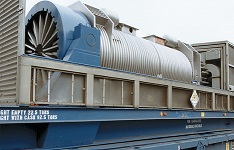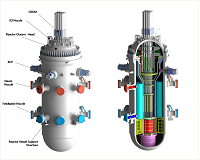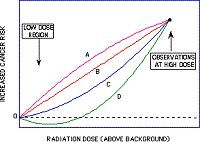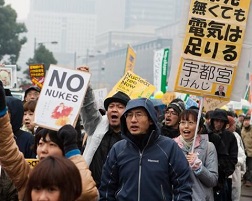But alas, this doesn't seem to matter to the public, or policy-makers, or regulatory agencies. Their apparent view is that even small, or very rare, amounts of nuclear-related pollution are completely unacceptable, whereas continual pollution from other sources (most notably fossil fuels) is not a serious concern. They continue to just ignore what the numbers, and experts, are telling them, concerning relative risks/impacts.
The question is: What can possibly be done to change this unacceptable (in my view) situation? As it seems I cannot fit all my thoughts on this matter into a single article of reasonable length, I will begin this month by discussing a few ideas that are held by many in this industry as to what should be done. Next month, I will explore another idea that I have, which (it seems) hasn't been considered.
Improved technology
Most of us who work in the nuclear industry are scientists and engineers, so there is a tendency for us to think the answer to the industry's problems (reactor safety, waste, etc.) is the development of better technology (e.g., advanced reactors and fuel cycles). There is a tendency to believe that inadequate technology is the source of the problem, and that once better technology is developed, the problems will go away. The public will accept nuclear with open arms, it will be competitive economically, and it will capture increasing market share.
My belief is that this view is largely naive. As I said in last month's post, it is an attempt to apply a technological solution to what is not a technological problem. It is mostly a political, regulatory, and public prejudice problem, as opposed to any lack of objective, technological merit of nuclear power.
Waste
The waste "issue" provides a clear example. Even a hypothetical, perfect, closed fuel cycle still involves at least one repository (for fission products) and a waste longevity of ~500-1000 years. Any real, practically achievable fuel cycle will fall short of that. Waste will still have to be shipped to the repository, and so the transport "issue" will not go away.
 It is, frankly, naive to think that having a somewhat shorter (but still unfathomably long for the public) waste life will reduce public/political opposition to a repository one iota. It shows a complete misunderstanding of the source of opposition. Opposition is NOT about genuine concern for the well being of people living in what is currently Nevada from 10,000 to 100,000 years from now. It is about feeling singled out as the nation's sole "waste dump" and the sense that a repository is being imposed, rather than being voluntarily agreed to. That, along with fears of transport accidents and various scares that may drive away tourism or reduce property values. None of these issues will be solved or even ameliorated by advanced/closed fuel cycles.
It is, frankly, naive to think that having a somewhat shorter (but still unfathomably long for the public) waste life will reduce public/political opposition to a repository one iota. It shows a complete misunderstanding of the source of opposition. Opposition is NOT about genuine concern for the well being of people living in what is currently Nevada from 10,000 to 100,000 years from now. It is about feeling singled out as the nation's sole "waste dump" and the sense that a repository is being imposed, rather than being voluntarily agreed to. That, along with fears of transport accidents and various scares that may drive away tourism or reduce property values. None of these issues will be solved or even ameliorated by advanced/closed fuel cycles.
The real truth is that nuclear's (tiny, contained, and well managed) waste stream has always been and always will be an orders of magnitude smaller risk (short term and long term) than the wastes and toxins of other industries. The real problem has always been the public not understanding that, as opposed to any lack of technology. No technology will solve that (real) problem.
It's not as though the news is all bad on the waste front, however. It appears that local communities in both New Mexico and Texas have voluntarily expressed support for the idea of hosting a high level waste repository. Not only that, but their state governments (usually the real source of political resistance) have expressed a willingness to at least consider the idea. Both provide an example of the change in the public acceptance and political equation that occurs when the initiative is voluntary.
Reactors
With respect to reactor accident risk, many advanced reactors and small modular reactors claim core damage or accident frequencies that are orders of magnitude lower than those of today's reactors. But again, do you really think that talking to the public about probabilistic risk assessment analyses and 10-8 vs. 10-4 core damage frequencies will have any significant effect on public opposition? If they were numerate, and based their views on scientific, numerical analyses, they wouldn't be opposed to nuclear (including today's reactors) in the first place. For them, an accident is either "possible" or it's not.
 It could be plausibly argued that essentially precluding even one significant accident or release, any time this century, would reduce the risk of negative political reaction that could significantly set back the industry (like what's happening in Japan). But I would argue that the probability is already quite low, especially given post-Fukushima improvements and lessons learned (along with the lack of tsunami and 9.0 earthquake potential in the United States).
It could be plausibly argued that essentially precluding even one significant accident or release, any time this century, would reduce the risk of negative political reaction that could significantly set back the industry (like what's happening in Japan). But I would argue that the probability is already quite low, especially given post-Fukushima improvements and lessons learned (along with the lack of tsunami and 9.0 earthquake potential in the United States).
In any event, the biggest issue for new reactors is not lack of public acceptance, but cost. This is especially true in the Southeast, where most new reactors would be built anyway. If nuclear isn't cost effective, the possibility of the industry's political rejection some decades from now due to a severe accident is moot, since the industry will have died off anyway. Some feel that advanced reactors will be far less expensive, but this is debatable and remains to be seen.
Many concepts, such as SMRs, give up size and power density in exchange for inherent safety advantages, resulting in the far lower accident probabilities discussed above. The lower power density and smaller size will tend to make SMRs more, not less, expensive. The hope is for volume production to reduce cost. However, what's really needed is to use the SMR's, or advanced reactor's, fundamental advantages to reduce cost, as opposed to further reducing (already extremely low) accident risk. What needs to be discussed is what other (Nuclear Regulatory Commission/quality assurance) requirements can be relaxed so that accident risk is a little better than current plants, but costs are significantly reduced. However, any such discussion would be blasphemous, for both the public and the NRC. Never mind the fact that requiring reactor accident risk to be as low as possible simply means that fossil fuels will be used instead, resulting in a large increase in public health risk.
Also unclear is the real benefit of having a reactor with a smaller potential source term, such as an SMR. The current public and regulatory mindset strongly suggests that smaller releases will simply result in stricter dose criteria being applied, with little reduction in cleanup cost or response in general. It will be 100 mrem/year, or even 10 mrem/yr, vs. 1,000 or 2,000. The dynamic is that the industry will have to "give until it hurts." "How much does it cost? How much you got?!" If you doubt this, note that many states have applied a criterion of 10 mrem/year to an ultra-hypothetical, most-exposed individual, for plant decommissioning projects. (The cost-per-life-saved on that criterion is incalculable....)
The real question is whether any technology can compete if there is such prejudice against it and if it is held to standards thousands of times as strict as competing sources. One approach is to develop some miracle technology that can compete even under a spectacularly unfair playing field. Another is to try and make the playing field more fair. Suffice it to say that I have strong views on which path is more likely to be successful.
Repudiating LNT
Many in our industry believe that the answer lies in winning the scientific debate on the health effects of low-level radiation. The goal would be to obtain a formal rejection of the Linear No Threshold Theory (LNT) by the world scientific community. In its place, a dose rate threshold would be established, below which it would be recognized that there are no health impacts.
 What this threshold would be is open for debate. One idea would be ~1 Rem/year, as that is roughly the top end of fairly common natural background levels, since no evidence of correlation between natural background level and disease rates have been found. Another often mentioned number is 10 Rem/year, the lowest dose rate for which clear statistical evidence of health impacts has been found. Some advocate even higher threshold values.
What this threshold would be is open for debate. One idea would be ~1 Rem/year, as that is roughly the top end of fairly common natural background levels, since no evidence of correlation between natural background level and disease rates have been found. Another often mentioned number is 10 Rem/year, the lowest dose rate for which clear statistical evidence of health impacts has been found. Some advocate even higher threshold values.
At that point, ostensibly, government policies would be changed in response to the new scientific consensus. That would include post-accident (release) evacuation policies, cleanup standards, and standards for radiation levels in food and water. Performance requirements for repositories would also be (dramatically) changed.
While all of this will definitely help, I have doubts as to whether it will be sufficient to achieve the needed changes. The problem with this idea, again, is that it assumes that public opposition, or even regulatory policy, is objective and rational in nature, and not subject to political influence and prejudices. As I've shown through numerous examples, the public, politicians, and even regulatory agencies are already ignoring science, and what the scientific community says.
 Even assuming the LNT, nuclear's public health risks and environmental impacts are orders of magnitude lower than those from fossil fuels. Even assuming the LNT, the total eventual impact of Fukushima (the only significant release of pollution in non-Soviet nuclear's entire history) is less than that inflicted every day by fossil fuels. And yet, after Japan considered setting a reasonable (~1
Even assuming the LNT, nuclear's public health risks and environmental impacts are orders of magnitude lower than those from fossil fuels. Even assuming the LNT, the total eventual impact of Fukushima (the only significant release of pollution in non-Soviet nuclear's entire history) is less than that inflicted every day by fossil fuels. And yet, after Japan considered setting a reasonable (~1





